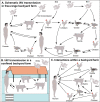A systematic review of influenza A virus prevalence and transmission dynamics in backyard swine populations globally
- PMID: 35287744
- PMCID: PMC8919175
- DOI: 10.1186/s40813-022-00251-4
A systematic review of influenza A virus prevalence and transmission dynamics in backyard swine populations globally
Abstract
Background: Backyard swine farming is critical to generating subsistence and food security in rural and peri-urban households in several developing countries. The objective of this systematic review was to analyze the molecular and serological prevalence of influenza A virus (IAV) in backyard swine populations globally.
Results: We identified 34 full-text research articles in NCBI-PubMed and Google Scholar databases that have reported IAV sero- and/or virological prevalence in backyard swine up to 11 July 2021. The highest number of studies were reported from Asia (n = 11) followed by North America (n = 10), South America (n = 6), Africa (n = 6), and Europe (n = 1). While the maximum number of studies (44.12%) reported human-to-swine transmission of IAV, swine-to-human (5.88%), poultry-to-swine (5.88%), and wild birds-to-swine (2.94%) transmissions were also reported. An overall higher IAV seroprevalence (18.28%) in backyard swine was detected compared to the virological prevalence (1.32%). The human-origin pandemic A(H1N1)pdm09 virus clade 1A.3.3.2 was the more frequently detected IAV subtype in virological studies (27.27%) than serological studies (18.92%). In addition, the avian-origin highly pathogenic H5N1 and H5N8 viruses were also detected, which further substantiated the evidence of avian-swine interactions in the backyards.
Conclusion: Human-swine and avian-swine interactions in backyards may transmit IAV between species. Monitoring the circulation and evolution of IAV in backyard swine would help stakeholders make informed decisions to ensure sustainable backyard swine farming and public safety.
Keywords: Avian influenza; Backyard swine farming; Biosecurity; IAV outbreak; IAV pandemic; Influenza A virus; Interspecies IAV transmission.
© 2022. The Author(s).
Conflict of interest statement
The authors declare that they have no competing interests.
Figures










Similar articles
-
Exposure Practices to Animal-Origin Influenza A Virus at the Animal-Human Interface in Poultry and Swine Backyard Farms.Zoonoses Public Health. 2025 Feb;72(1):42-54. doi: 10.1111/zph.13182. Epub 2024 Sep 20. Zoonoses Public Health. 2025. PMID: 39304348
-
Influenza A Virus in Backyard Pigs and Poultry in Rural Cambodia.Transbound Emerg Dis. 2017 Oct;64(5):1557-1568. doi: 10.1111/tbed.12547. Epub 2016 Aug 2. Transbound Emerg Dis. 2017. PMID: 27484711
-
Molecular identification and phylogenetic characterization of influenza A virus at a wildlife-livestock interface in Mexico.Transbound Emerg Dis. 2021 Nov;68(6):3563-3573. doi: 10.1111/tbed.13962. Epub 2020 Dec 31. Transbound Emerg Dis. 2021. PMID: 33350099
-
Evolution and Current Status of Influenza A Virus in Chile: A Review.Pathogens. 2023 Oct 17;12(10):1252. doi: 10.3390/pathogens12101252. Pathogens. 2023. PMID: 37887768 Free PMC article. Review.
-
A Systematic Review Analyzing the Prevalence and Circulation of Influenza Viruses in Swine Population Worldwide.Pathogens. 2020 May 8;9(5):355. doi: 10.3390/pathogens9050355. Pathogens. 2020. PMID: 32397138 Free PMC article. Review.
Cited by
-
Characterization of a Near Full-Length Hepatitis E Virus Genome of Subtype 3c Generated from Naturally Infected South African Backyard Pigs.Pathogens. 2022 Sep 11;11(9):1030. doi: 10.3390/pathogens11091030. Pathogens. 2022. PMID: 36145462 Free PMC article.
-
The Role of Wildlife and Pests in the Transmission of Pathogenic Agents to Domestic Pigs: A Systematic Review.Animals (Basel). 2023 May 31;13(11):1830. doi: 10.3390/ani13111830. Animals (Basel). 2023. PMID: 37889698 Free PMC article. Review.
-
The genomic landscape of swine influenza A viruses in Southeast Asia.Proc Natl Acad Sci U S A. 2023 Aug 15;120(33):e2301926120. doi: 10.1073/pnas.2301926120. Epub 2023 Aug 8. Proc Natl Acad Sci U S A. 2023. PMID: 37552753 Free PMC article.
-
Overview of Diagnostic Methods, Disease Prevalence and Transmission of Mpox (Formerly Monkeypox) in Humans and Animal Reservoirs.Microorganisms. 2023 Apr 30;11(5):1186. doi: 10.3390/microorganisms11051186. Microorganisms. 2023. PMID: 37317160 Free PMC article. Review.
-
Drivers for a pandemic due to avian influenza and options for One Health mitigation measures.EFSA J. 2024 Apr 3;22(4):e8735. doi: 10.2903/j.efsa.2024.8735. eCollection 2024 Apr. EFSA J. 2024. PMID: 38576537 Free PMC article.
References
-
- FAO. Food outlook. In: Biannual report on global food markets. Food and Agriculture Organization of the United Nations; 2013, pp. 51–5.
Publication types
LinkOut - more resources
Full Text Sources

